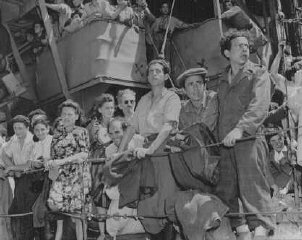The Balfour Declaration and the Mandate
Balfour Declaration (r) 
World War I created a dramatically new situation. The World Zionist Organisation was based in Germany and Turkey, the ruler of Palestine, was Germany’s ally. The British Zionist Federation under the chairmanship of Chaim Weizmann now became the centre of Zionist activity. By 1917, when it became clear that Turkish Palestine would come under British control, Weizmann was able to present the Zionist case to the British Government. With the historic Balfour Declaration, and the subsequent mandate, came the charter for a Jewish homeland envisaged by Herzl. (This was somewhat ironic, as Weizmann had always been sceptical of Herzl’s vision of a charter from the great powers, and regarded actual settlement and development – “another cow in Gedera” – as the Zionist priority.)
The Mandate had provided for an “appropriate Jewish Agency” to assist in the establishment of the Jewish national home, and in 1922 the British Government recognized the Zionist Organisation as that agency.
The Zionist movement now had the aims of developing the economy of Palestine, facilitating immigration, and conducting relations with the British Government. Their task was immensely difficult. Under an unsympathetic administration, land was purchased and Jewish immigrants worked to restore its fertility. Collective settlements were established, desert areas were developed, trees planted and malarial swampland drained. Infrastructure, including the electricity company created by Pinchas Rutenberg, came into existence, industries were established and the city of Tel Aviv, founded in 1908, started to grow from the sand dunes. As a result of the attraction of this economic development, the Arab population of the region doubled between 1917 and 1946.
At the same time, Arab riots in opposition to Jewish settlement led to Royal Commissions and subsequent White Papers in 1922, 1930 and 1939 which drastically limited Jewish immigration and settlement. Meanwhile the situation of the Jews in Europe became increasingly desperate with the threat of the approaching holocaust.
The Zionist movement continued to grow in Jewish communities throughout the world. The Zionist Federation of Australia and New Zealand was formed at a conference in Melbourne in 1927, under the presidency of Sir John Monash, the former General Officer Commanding the Australian Imperial Force (AIF) in Europe during the First World War.
 Major General Sir John Monash, first president of the Zionist Federation of Australia and New Zealand
Major General Sir John Monash, first president of the Zionist Federation of Australia and New Zealand





 Members of the Hovevei Zion group of Vilnius
Members of the Hovevei Zion group of Vilnius


 Major General Sir John Monash, first president of the Zionist Federation of Australia and New Zealand
Major General Sir John Monash, first president of the Zionist Federation of Australia and New Zealand Illegal Jewish immigrants crowded onto ships bound for Palestine
Illegal Jewish immigrants crowded onto ships bound for Palestine 